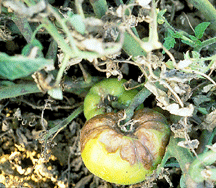
Volume XVII, Issue 35 # August 27 - September 2, 2009 |
 |
|
The Bay Gardener
 by Dr. Frank Gouin |
A Moral for Gardeners
Don’t let weeds go to seed
By mid to late summer, weeds begin to mature, which means that they have flowered and produced seeds. If you allow these seeds to mature and disperse in your garden, your weed problem will be much more severe next year. However, if you pull or mow those weeds before the seeds mature, you will find gardening less of a chore next year.
Most weeds now growing in the garden are summer annuals. This means that their seeds germinated in late spring, and the weeds grew from only a few inches tall to several feet tall, then flowered, leaving seed heads. As soon as those seeds mature, the plant will die. In other words, the weeds will have completed their life cycle in one growing season.
Pulling the weeds or mowing them before the seeds mature will significantly reduce the number of seeds that will return to the ground to become a problem next year — and in years to come.
Not all of the seeds will germinate next year. Weed seeds have the uncanny ability to remain dormant in the ground for years. Research has demonstrated that the seeds of some weeds are capable of remaining dormant in the ground for 60 years or more. Those numbers dwindle with time, but most garden soils are heavily infested with dormant weed seeds.
Keeping the garden free of weeds is an important chore in gardening. The more we do in controlling weeds, the fewer weeds become problems. Eliminating weeds when they are small is easier than having to get down on your knees and pull them out when they are big.
Research has demonstrated that cultivating the soil in the early morning hours or in the evening just before the sun sets results in fewer weed problems. This is because germination of many weed seeds is triggered by exposure to the red light of the sun. Thus disturbing the soil as little as possible is also a good way of controlling weeds.
So the strategy is to hoe out individual weeds — not the whole garden — and not to cultivate, especially during daylight hours.
The moral of the story is the better job you do at preventing weeds from producing mature seeds, the easier it will be to garden next year.

 Why the Bad Guys Win
Why the Bad Guys Win
Q Why has there not been any progress on late blight in tomatoes? This is the same pathogen that devastated the Irish potato crop and is still causing problems today. Can’t genetic engineering or cross breeding or DNA splicing be used to make a resistant tomato or potato plant?
–via email
A The problem is most likely funding research. Just think: Billions have been spent on cancer research, yet the problem has not been solved.
I am a plant physiologist and not involved in genetic engineering or gene splicing. We have made some progress with the use of fungicides, but the problem comes with the disease developing resistance to pesticides. Bordeaux was one of the most effective fungicides available to control late blight; then a fungicide called Bravo took its place. Now the disease appears to be growing resistant to Bravo.